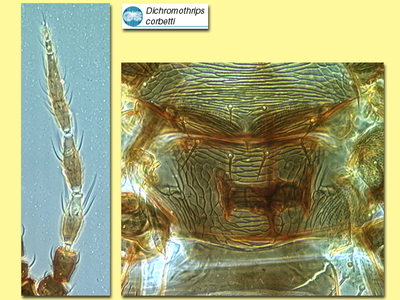Figures
Fig. 1 Antenna, meso and metanotum
Fig. 2 Fore and hind wing
Fig. 3 Tergite III
Fig. 4 Tergite VIII (female)
Species
Dichromothrips corbetti Priesner
Biology
This south east Asian species is sometimes common on orchid plants and orchid flowers, but seems to have been largely replaced by Thrips palmi on commercially grown orchids since the 1980's.
Distribution
Apparently widespread in south east Asia, it has been introduced on orchids to many parts of the world, but without becoming a serious pest.
Recognition
Medium sized, dark brown thrips with dark forewings that are pale at the base, and antennal segments III & IV with apex pale. Antennae 8-segmented, sense cones on III & IV forked. Head with no setae in front of fore ocellus, ocellar setae III arising lateral to the ocellar triangle. Pronotum with no long setae. Metanotum with about 8 transverse lines of sculpture, median setae arising just behind anterior margin. Forewing with 3 setae distally on first vein, complete row of setae on second vein. Tergites with no sculpture medially, but 8 or 10 closely parallel lines laterally; VIII with posteromarginal comb of long fine microtrichia. Male sternites each with a pair of glandular areas.
Related species
The genus Dichromothrips includes 16 described species, all from orchids in the Old World tropics between Africa and Australia.





